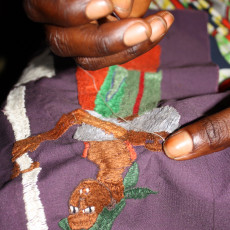To be honest, I knew little to nothing about quilts three months ago. Nevertheless, I learned as much as I could in the last few months to bring the ambitious “SOS FED Quilt Project” to fruition. I learned that a quilt does not just serve the utilitarian purpose of keeping one warm, but can also be an artistic means of storytelling. I learned about the rich cultural history quilts have left behind and the manner in which quilters use their craft to escape isolation, express themselves, and bridge cultural, racial, and geographic gaps. The more I learn about quilting, the more I am convinced that this is the perfect medium for the women of SOS FED to share their stories with the world.
I had no idea the amount of planning that goes into making a story quilt. First, the quilter must choose a central idea or theme. Second, the quilter chooses the shapes, fabrics, colors, and technique they will use to achieve their vision. Third, the quilter decides the layout of the quilt—how the tiles will be placed in order to most effectively tell their story. Fourth, the quilter considers tile coordination and collection. After many hours meeting with Marceline Kongolo-Bice and Amisi Mas, SOS FED’s founders, we polished each of these four crucial elements of story quilt planning. I will share only a few of the SOS FED quilt elements here. The purpose, or theme, of the SOS FED quilt is to share with the world the lives of about 100 women in South Kivu. Sub themes, such as war, sexual violence, women’s role in society, SOS FED services, recovery, and continued hardship, will provide the quilt’s narrative. We will rely on pagné, traditional African fabric, for the quilt’s aesthetic.
The level of enthusiasm I have seen for this project is great. The women at all three of SOS FED’s centers are eager to get started on this project, and I think that given their sewing abilities, the quality of this quilt will be high.
Posted By 2010 Fellow
Posted Jul 12th, 2010

